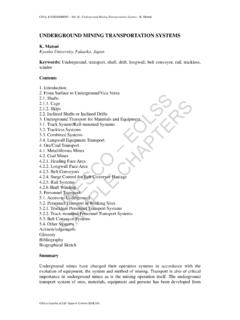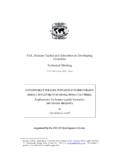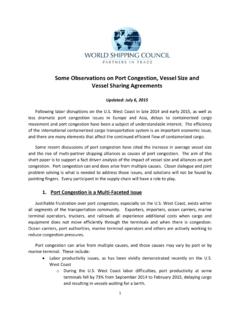Transcription of (Version June 2007) - OECD
1 Tax Incentives for Investment A Global Perspective: experiences in MENA and non-MENA countries Draft1. ( version june 2007 ). Contacts: Steven Clark; Tel. +33 1 45 24 9666, e-mail: Ana Cebreiro, Tel. +33 1 45 24 1842, e-mail: Alexander B hmer, Tel. +33 1 45 24 1912, e-mail: 1. Information on the tax systems of MENA countries still need to be confirmed by country representatives. 1. Introduction .. 3. 2. factors influencing foreign direct 3. 3. Pros and cons of main tax incentives used through corporate income 6. 4. Main tax incentives offered in MENA countries .. 8. 5. Some empirical evidence on effectiveness of tax incentives .. 10. Experiences in other 10. Two success stories of eliminating tax incentives: Uganda (1997), Indonesia (1984).
2 11. Experience in the MENA region .. 11. Moroccan Tax Expenditure 11. New Egyptian Income Tax Law .. 12. Tunisia (FIAS) .. 13. Jordan (Institute for International Business, University of Toronto) .. 13. Tax Incentives Reforms and FDI Performance Index .. 14. 6. Overview of the tax systems in the MENA region as potential host countries for 15. Headlines tax rates and FDI Performance Index .. 16. Other features to consider in the design of a tax system supportive for 16. 7. Conclusions .. 18. References .. 20. Annex 1. Definition of main fiscal 21. Annex 2. Tax incentives: Country details .. 23. 2. 1. Introduction 1. The purpose of the present paper is to analyse the effects of the use of tax incentives on foreign direct investment performance in the Middle East and North Africa (MENA) region, based on a review of international best practice and some empirical evidence.
3 It is hoped that the discussions in Working Group 3 (Tax Policy for Investment) of the MENA-OECD Investment Programme will provide a forum for information updating and peer review on this issue. 2. All MENA countries offer direct and/or indirect investment incentives to boost employment, encourage the development of the private sector and improve their competitive position in today's global economy. During the past twenty years, incentives in many respects have become an important policy tool of many MENA governments to increase their share of investment in order to gain the attention of potential investors and to stay competitive with other countries offering incentives.
4 While most international studies have shown that general economic and framework conditions, rather than incentives, are far more important in determining the size and quality of investment flows, incentives can compensate for market failures, are seen as easy to implement, and often seen as effective policy tools for achieving economic and social objectives. 3. Some MENA countries have multiple laws offering incentives, whose design and administration is the responsibility of separate ministries. Responding to pressure from investors, these ministries in many cases have made existing incentives more generous and increased the number of new incentives. Often these different ministries do not coordinate their work on incentives, with the result that the incentives often overlap, are not entirely consistent, or work at cross-purposes.
5 Many incentives are also readily exploited by investors, as well as by those administering them. 4. Despite the popularity and widespread use of incentives in the MENA region, there generally have not been systematic reviews of the effectiveness of the various incentives offered, either by individual countries or at a regional level. In many countries, there is an absence of reliable data on actual investments made, direct and indirect benefits to the host economy and the cost of the incentives in terms of direct spending or revenue lost. 5. This paper is organised in seven sections. Section 2 summarises the main factors that influence investment location decisions. Section 3 describes the main advantages and disadvantages of tax incentives used through corporate taxation.
6 Main tax incentives used in the MENA region are summarised in Section 4. Some empirical evidence on the effectiveness of the use of tax incentives is presented in Section 5, including two cases of successful elimination of tax incentives. Section 6 discusses other tax features relevant on investment location decisions besides tax incentives. Section 7 concludes. 2. factors influencing foreign direct investment 6. There is a consensus in the literature about the main factors affecting (foreign) investment location The most important ones are market size and real income levels, skill levels in the host economy, the availability of infrastructure and other resource that facilitates efficient specialisation of production, trade policies, and political and macroeconomic stability of the host country (see Table 1).
7 3. The relative importance of the different factors varies depending on the type of investment. 2. See for example Dunning (1993), Globerman and Shapiro (1999), and Shapiro and Globerman (2001). 3. Some of the MENA countries offer a quite good physical investment climate ( modern roads, ports and electricity grids), a reasonably well-educated labour force, and have at least taken steps toward raising 3. Table 1: factors influencing FDI. Non-tax factors market size access to raw materials natural resources, energy supplies availability and cost of skilled labour access to infrastructure transportation costs access to output markets high consumer demand in region, low export costs political stability macro-economic stability financing costs Tax factors Transparency, simplicity, stability and certainty in the application of the tax law and in tax administration Tax rates Tax incentives 7.
8 Additionally, the location of foreign direct investment (FDI) may be influenced by various incentives offered by governments to attract multinationals. These incentives include fiscal (or tax). incentives (such as reduced corporate tax rates),4 financial incentives (such as grants and preferential loans to multinationals), as well as other incentives like market preferences and monopoly rights. 8. Survey analysis shows that host country taxation and international investment incentives generally play only a limited role in determining the international pattern of FDI ( manufacturing FDI). factors like market characteristics, relative production costs and resource availability explain most of the cross-country variation in FDI inflows.
9 Transparency, simplicity, stability and certainty in the application of the tax law and in tax administration are often ranked by investors ahead of special tax incentives. Control of government finances is also identified as a key element, which helps provide stability in tax laws and thus greater certainty over tax treatment, as well as greater stability and less risk in the economy overall. 9. An example illustrating these empirical findings is a recent survey of investors in South East Europe (OECD (2003)). In particular, this survey can give a flavour on how tax systems are perceived by investors. This survey suggested that strategic investors consider tax factors as only one of the obstacles to investment (counting only 24 per cent), instability and unpredictability of the tax system (adding risk).
10 Being perceived the key tax impediments. Tax issues were not mentioned in the responses of the opportunistic investors, indicating that they were not so important in the decision making process (see Figure 1). administrative and regulatory efficiency. However, more remains to be done, and investors are much stronger attracted to some economies than to others. 4. Fiscal incentives are defined as those special exclusions, exemptions, deductions or credits that provide special credits a preferential tax treatment or deferral of tax liability. Tax incentives for foreign direct investment (FDI), are often structured through income tax systems, providing relief from corporate-level taxes on income from capital ( , tax holidays, reduced corporate tax rates, special corporate tax deductions, allowances and credits), and in some cases providing relief from personal income tax ( , imputation relief, preferential tax treatment for expatriates).
















